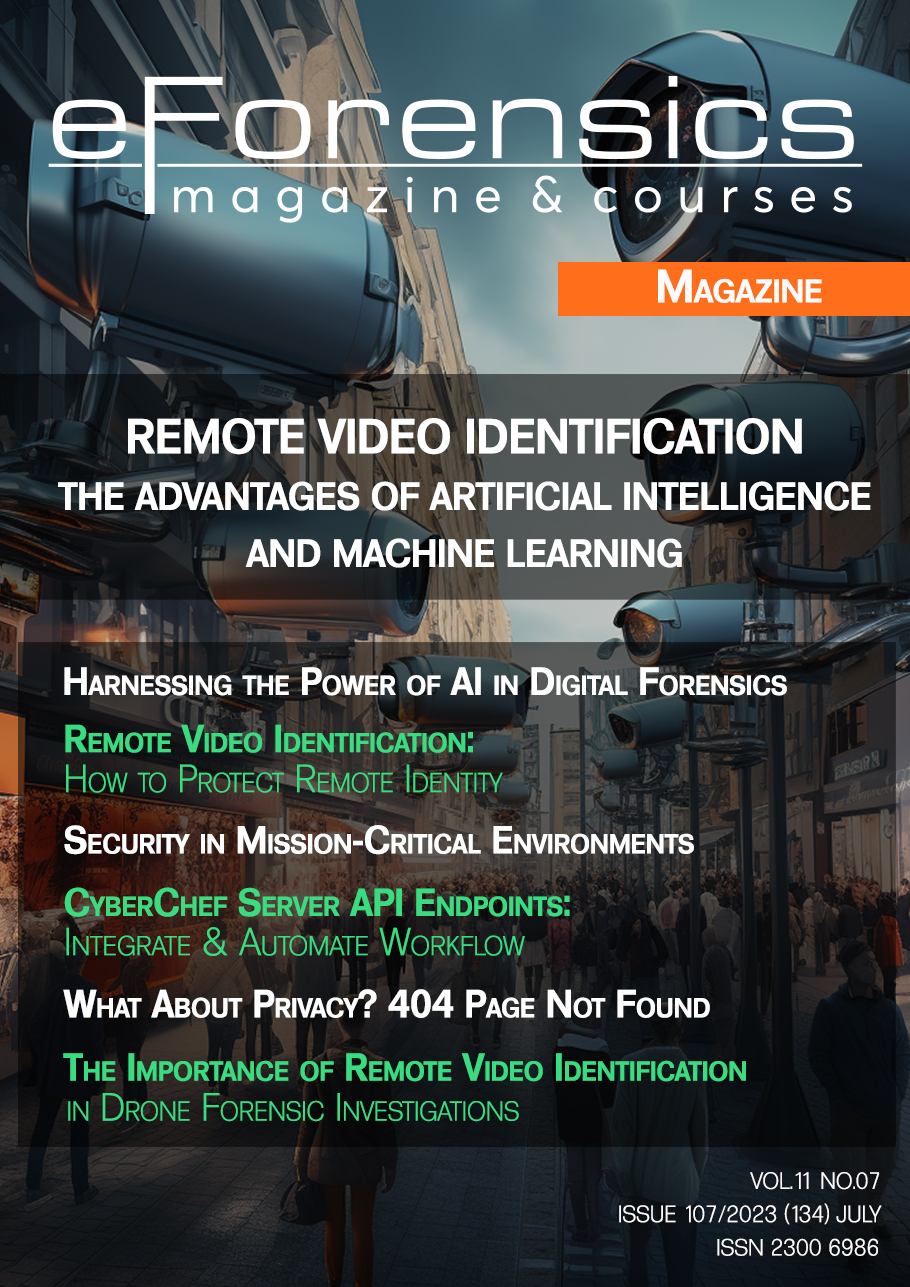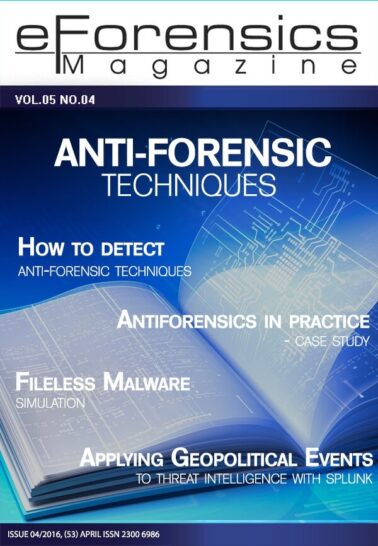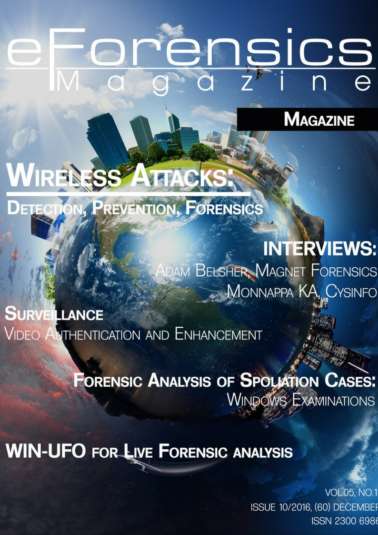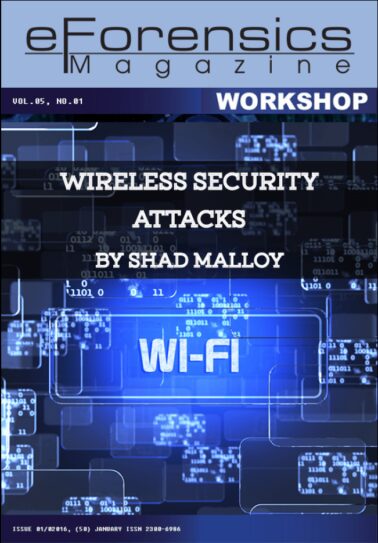No products in the cart.
EDITOR’S WORD
Dear Readers,
I hope everything is going well for you. This month's edition is dedicated to Remote Video Identification. We are highlighting this important topic in digital forensics and emphasizing the critical role that AI plays in this field of investigation.
We are very pleased with the fact that eForensics is publishing the special issue, which includes all of Israel Torres' articles. In 'The Israel Torres Compendium,' he delves into various sub-topics such as malware, obfuscation, macOS, Linux, GPT, cryptography, and communications.
Finally, I would like to thank you for all of your assistance, kind words, and efforts in making this issue a success. Thank you to all of our reviewers, proofreaders, authors, and team members who contributed significantly to the creation of this issue. I encourage you to read Imprint to get to know our team.
Have fun reading!
Ewa & eForensics Team
TABLE OF CONTENTS
SAFEGUARDING REMOTE VIDEO IDENTIFICATION: A LOOK AT DRONE CYBERSECURITY
RHONDA JOHNSON
Unmanned aerial vehicles (UAVs), commonly known as drones, have revolutionized various industries, and one of their critical applications is remote video identification. This technology enables real-time monitoring of distant locations, providing invaluable assistance in fields such as law enforcement, disaster response, and infrastructure inspection. Rhonda, in her article, will examine drone cybersecurity in the context of remote video identification, supported by recent news items and statistics.
REMOTE VIDEO IDENTIFICATION
KATE LIBBY
In today's digital age, remote video identification has emerged as a powerful solution for verifying the identity of individuals without requiring their physical presence. This technology has applications in various industries, such as government, finance, healthcare, telecom, and intelligence services, just to name a few, revolutionizing processes, such as account onboarding, passport identification, remote transactions, and customer support. In this article, Kate will explore the technologies and methods used in remote video identification and examine their impact on different sectors.
ENISA VIDEO REMOTE IDENTIFICATION GUIDELINES
PAULO PEREIRA, PHD
This article presents the topics debated in the Remote Video Identification: Attacks and Foresight Workshop held by ENISA (European Union Agency for Cybersecurity) on last 10 May 2023 and in the report Remote Identity Proofing: Attacks & Countermeasures, published in 2022. In recent years, the expansion of video cameras scattered throughout the streets of cities and inside buildings has had great growth. Certainly, with this demand, the exposure of the information recorded in these videos became the target of cyber attackers interested in gathering such information to blackmail people and companies and sell possible secrets contained in the images.
SECURITY IN MISSION-CRITICAL ENVIRONMENTS: IMPLEMENTATION OF DEFENSE-IN-DEPTH PROTECTION LAYERS
C.M. LIMA JR , E.L. PELLINI
With the increase of cyber threats targeting companies in the electric, water, and oil sectors, cybersecurity has become essential to protect networks and ensure operational continuity. Despite the best preparation efforts, the rapid evolution of cyber threats and the constant emergence of new vulnerabilities always pose risks of attack.
THERE ARE THREE CYBERCHEFS!
ISRAEL TORRES
Welcome, let's begin our journey through the practical use of GCHQ's CyberChef versions. CyberChef is aptly declared "The Cyber Swiss Army Knife - a web app for encryption, encoding, compression, and data analysis". In this article, Israel will continue using these same crafted examples to dive deeper using a few versions of CyberChef that include the popular default online web app, the lesser-known local installation, and the least-known server mode. This article will cover the usefulness of the CyberChef Server API's endpoints bake and magic in conjunction with using scripts to integrate and automate our workflows. You will also learn how to create and test queries from the server UI itself.
HARNESSING THE POWER OF AI IN DIGITAL FORENSICS: INTEGRATING TECHNOLOGY AND TRADITIONAL TECHNIQUES FOR COMPREHENSIVE INVESTIGATIONS
JUSTIN TOLMAN, FORENSIC SUBJECT MATTER EXPERT, EXTERRO
As artificial intelligence (AI) makes its way into every industry, it’s met with excitement and doubt—for good reason. With the potential to revolutionize industries, improve efficiency, and enhance our lives, we can only expect to see growing concerns about job displacement, ethical implications, and the potential for misuse of AI technology.
OVERCOMING INFORMATION OVERLOAD:
HOW TO EFFICIENTLY EXTRACT CRUCIAL CASE DETAILS FROM COLLABORATION PLATFORMS
Understanding and Countering Information Overload in Collaboration Platforms
ANDREAS MUELLER
Collaboration platforms have become a ubiquitous tool in our professional lives. They bring teams together, foster collaboration, and streamline workflows. Yet, with the massive influx of information, we often find ourselves drowning in a sea of messages, updates, shared files, and notifications. This phenomenon, known as information overload, can severely impact legal analysis and review.
PRIVACY?
404 PAGE NOT FOUND
WILSON MENDES
In recent years, remote video identification has been a topic of great interest in the current context of surveillance and security technologies, becoming a technology increasingly used around the world. In this article, Wilson will delve into an identification and scoring system, sifting through images of people, exploring concerns raised, and analyzing the two main methods of identification and video surveillance around the world. We then discuss some of the advanced algorithms used to identify and recognize objects, activities, marks, and faces in videos.
DATA LOSS PREVENTION (DLP)
HOW TO FIND THE BALANCE BETWEEN COMFORT AND SECURITY
SERGIO BERTONI, THE LEADING ANALYST AT SEARCHINFORM
Whenever employee control is implemented, a general dislike is evident from employees. However, ensuring the monitoring of employees’ activities is an inevitable necessity. So, the question arises: which form of control annoys employees less? On an example of an illustrative case, the following discussion explains why a DLP-system, which is often considered to be a strict tool, causes less stress than other tools, aimed at control of employees.
Only logged in customers who have purchased this product may leave a review.





Reviews
There are no reviews yet.